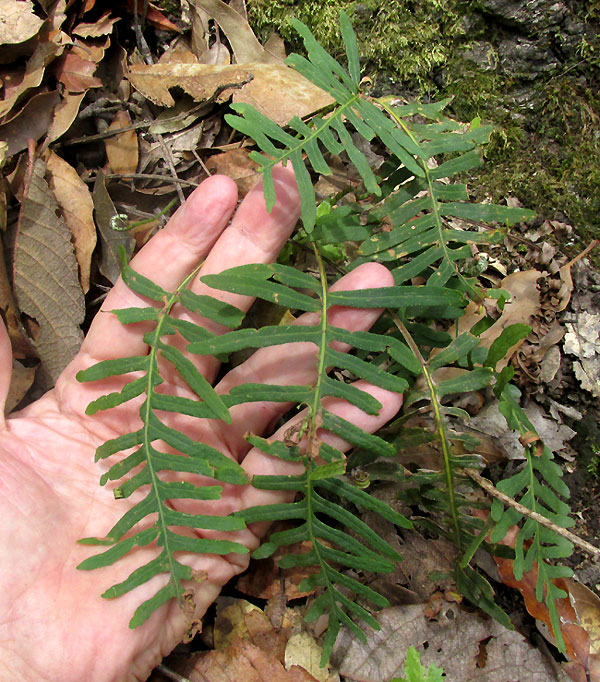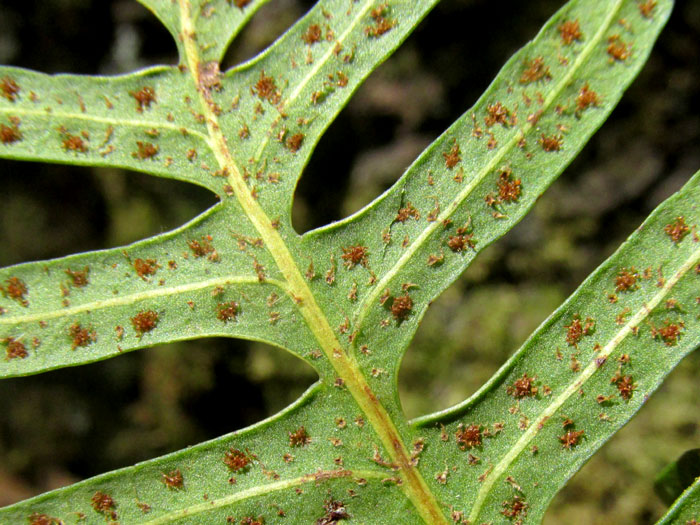Excerpts from Jim Conrad's
Naturalist Newsletter
entry from field notes dated July 28, 2022, taken in an oak forest on the slopes of Cerro de la Cruz, elevation ~2750m (~9000 ft), rising on the south side of the community of El Pinar, Amealco de Bonfil, Querétaro, MÉXICO, (~N20.17°, ~W100.17°)
SCALY POLYPODY

On the steep northern slope of Cerro de la Cruz the above fern grew at the moss-covered base of an oak tree right where the trunk entered the ground's deep carpet of last season's dried leaves. This and other individuals of the species on the slope gave the impression that they preferred the epiphytic lifestyle, but needed a little more moisture and warmth than the open air offered on that slope.
This fern's general form is similar to numerous other species, so for identification purposes a closer look was needed:

Note that the frond's lobes are not completely separated from one another at their bases; a very narrow wing of tissue along the frond's midrib, or rachis, connects the lobes. The lobes themselves bear no teeth or ondulations.
An interesting feature is the tiny, white spots along each lobe's margins. Probably those are "hydathodes," which are organs helping certain plants expel water through the process of guttation, sometimes forming droplets of water visible on the fern's upper surface. In a 2022 publication by Klaus Mehltreter and others entitled "Hydathodes in ferns: their phylogenetic distribution, structure, and function," it's stated that hydathodes are known from 1,189 species in 92 genera and 19 fern and horsetail families. With an image search on the keywords "fern hydathodes" you can see a variety of hydathode appearances.

On the fronds' lower surfaces, the roundish collections of spore-releasing sporangia, known as sori, showed no trace of indusia. Indusia are little silvery scale-like things partly covering sori in some fern groups. Seeing their absence, it became clear that probably the species belonged to the big Polypody Family, the Polypodiaceae, to which about 500 species in around 40 genera currently are assigned. And it's true that this species is similar to what's known as Common Polypodies in both North America and Europe, though each continent has its own different Common Polypody species.

Up closer something important was seen: Mealy scales sparsely covered the undersurface.
The authoritative Flora of North America currently sums up the messy naming situation in the Polypody Family this way: "Limits of genera in both Old World and New World are controversial and are currently under study by several workers." However, a general trend, I read elsewhere, is to shift scaly-undersurfaced species out of the genus Polypodium into the "scaly polypody genus" Pleopeltis.
With all that in mind, and having no good overview of the Polypody Family in Mexico, the best I could do was to simply browse the Internet looking for Pleopeltis pictures matching our fern's features.
Especially taking into account the frond's general form, color, the way the frond lobe midribs, or costae, are so pronounced while secondary veins aren't apparent, the manner by which the costae attach to the frond's rachis at a curving angle, and the sparseness of the scales on the undersurface, it seems that here we have PLEOPELTIS PLEBEIA, which occurs throughout most of upland Mexico south to Panamá, mainly in oak, oak-pine and dry, grassy uplands. English speakers can refer to all Pleopeltis species as scaly polypodies. And at least some Pleopeltis species are known to have hydathodes
Though this species seems to be widely collected and occurs on many lists, not much general information is available on it. At least now we can tell the world that in central Mexico it occurs at about 2750 meters in elevation, on tree trunks, at least at the trunks' bases, and at least on northern slopes.